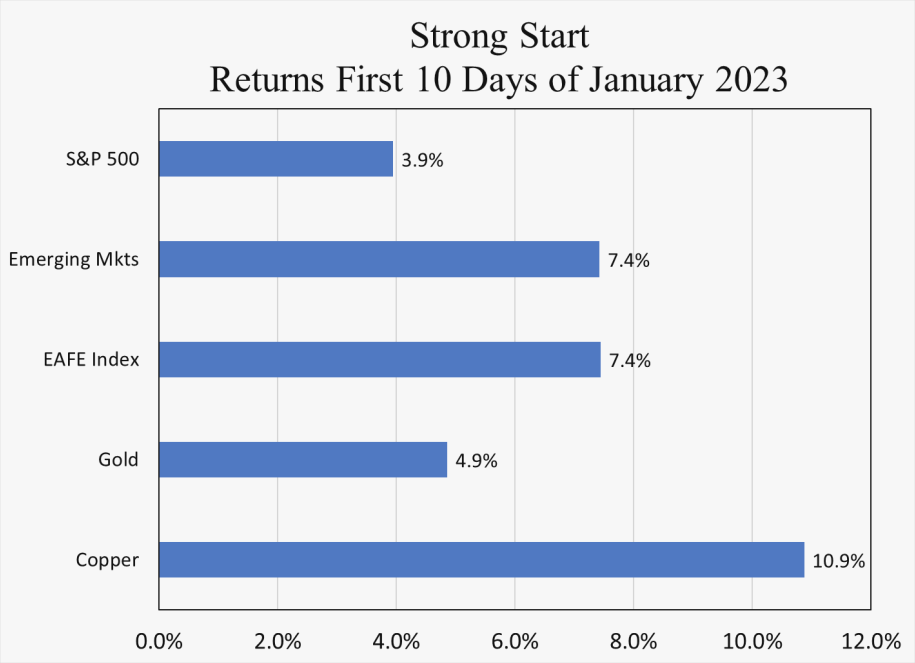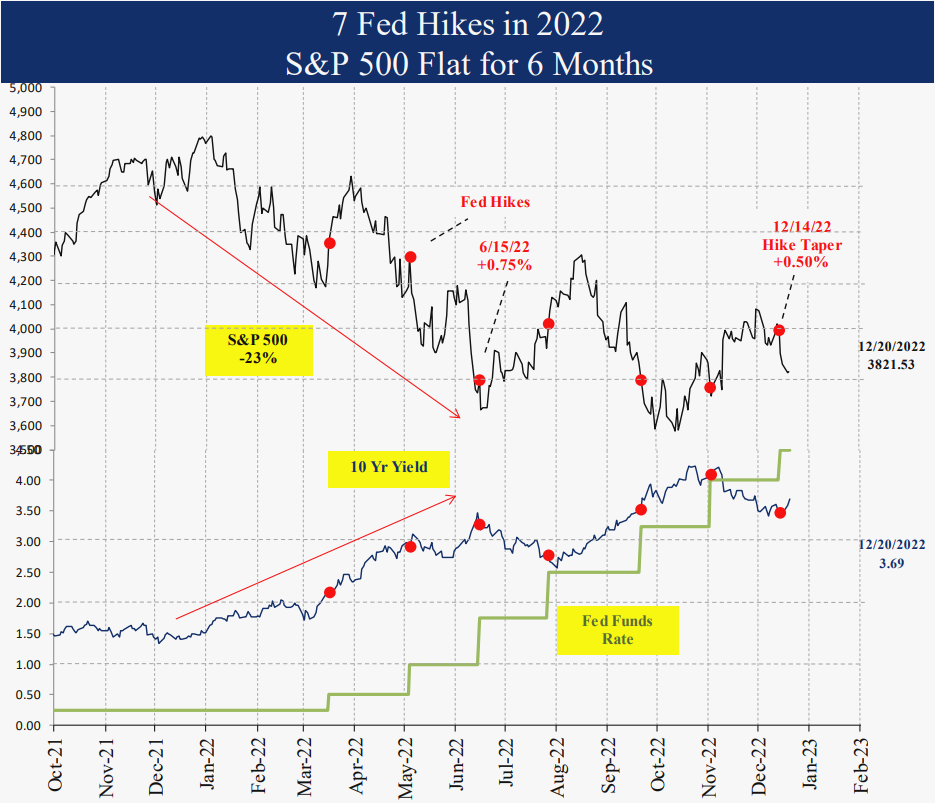Economic Outlook Indicators Best Since 2021
Investing Environment Review and Outlook – Volume 68
Last month we discussed the potential economic turning point and likely higher long‐term rates. Since then, the 10‐year Treasury yield rose 50 bps to 3.90%, pushing long term bond prices down 6%. We also discussed the bullish start to the year. The S&P 500 finished January up 6.2%. Prior cases since 1950 were followed by mixed returns and consolidation in February, then 90% of cases generated positive
returns 3 months later. 90% were also higher 6 months later by an average of 9.1%, almost 2x the norm. While the media reinforces the investor wall of worry with Ukraine, recession and Fed rate hike coverage, our economic outlook indicators improved this month, giving us more evidence the next move in the economy is to the upside instead. This month we discuss the obvious and some less intuitive implications of rising long‐term rates and a strong economic outlook during a Fed hiking cycle. Overall, conditions continue last month’s trends, which are primarily bullish for equities and commodities, and negative for bonds.
Long‐term bonds remain a cautious 2 rating. U.S., foreign‐developed, and emerging markets equities remain bullish 5 ratings. Gold and commodities remain bullish 5 ratings as well.
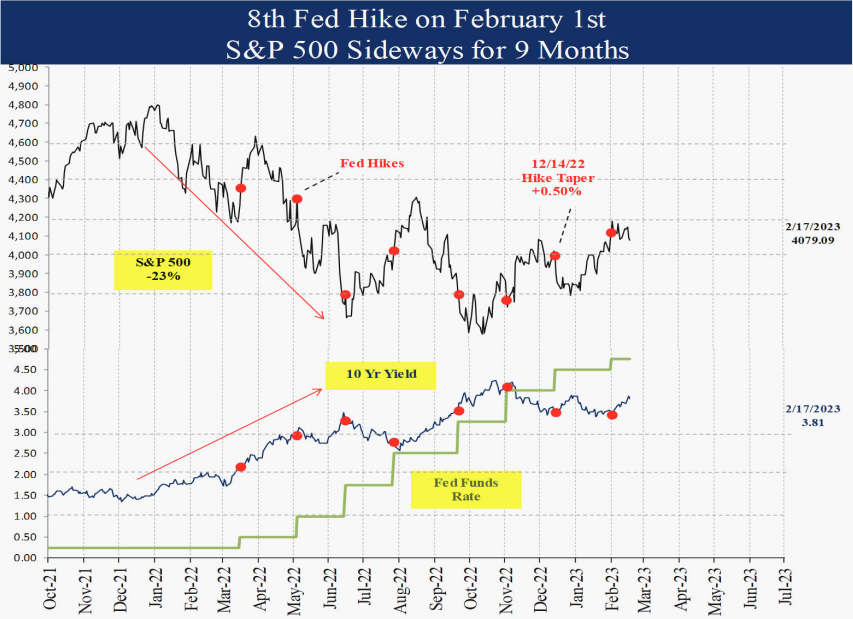
Economic Outlook Indicators Uptick: Positive for Stocks, Commodities, 10‐Yr Yield
Our economic outlook indicators reached 59.4 last week, a big reversal from the July 2022 low of 31. This is not to say there will be no recession this year, but instead shows the 1‐3 month direction of the economy, as measured by the ISM index, is likely higher. The model is driven primarily by bond, commodity, and equity prices rather than economic releases which are backward looking and lagged in their release.
Historically a strong economic outlook was bullish for commodities and higher 10‐year Treasury yields, both as you would expect following a strengthening economy. What is more interesting, and perhaps counter intuitive, is why a strong economic outlook is bullish for equities when the Fed is hiking rates. Consensus thinking knows without a doubt that at this point “good news is bad news” since it means more Fed hikes ahead, a continued bear market for equities and recession. End of story.
However, historically the S&P 500 returned 9.4% when the economic outlook was positive and the Fed was hiking rates, just about the norm. And further context boosts that return considerably. For instance, when the ISM is weak as it is now (+22.3% return), when CPI Y/Y is falling (+20.9%), and during Q1 (+22.8%). The strong (2x norm) return when the ISM is weak is particularly telling, since the latest weak reading (47.4 in the 13th percentile) means there is considerable slack in the economy for inflation to continue lower. The tight labor market is less of a concern since it is widely known as a lagging indicator and just one piece of the inflation picture.
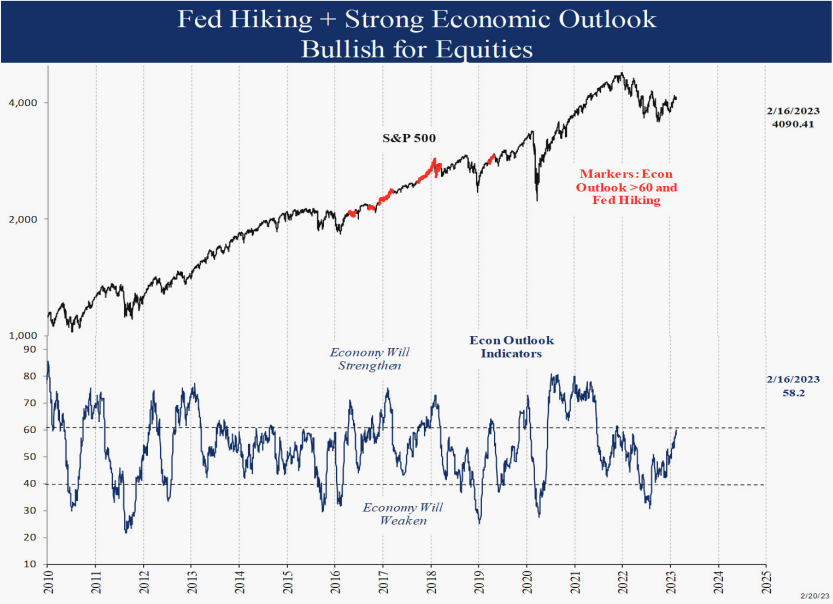
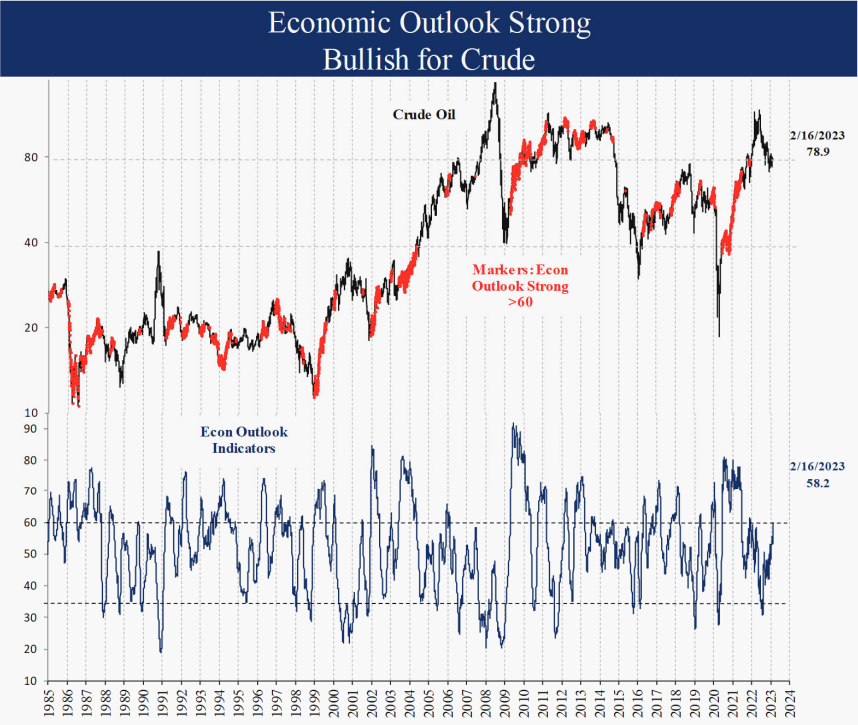
Inflation Decline: Further Drop Ahead
Falling inflation is a key bullish condition for equities this year, even if we cannot know if inflation will revert back to the 2% level as the Fed seeks. The combination of rising inflation, rising 10‐year yield and Fed hiking was toxic for equities in the first half of 2022. It is no coincidence that equities have performed better since June when the CPI peaked. A strong economic outlook might be confused with higher inflation and further Fed hikes. However, indicators show a potential further inflation drop ahead. First, the year ago comps for inflation averaged 0.8% M/M over the next 5 months, which provides a runway for lower Y/Y readings ahead. A lower M/M number this year compared to last year means the Y/Y will decline. If the next 5 months average 0.3% M/M (as the last 3 months did), the CPI Y/Y will be 3.5% by June. Secondly, the 5 prior cases of inflation spikes (1951, 1970, 1974, 1980 and 1990) have so far provided a simple yet accurate roadmap and shows further declines ahead. Finally, the consensus of economists expects 3.8% Y/Y by June, even lower than the norm in prior inflation spike cases.
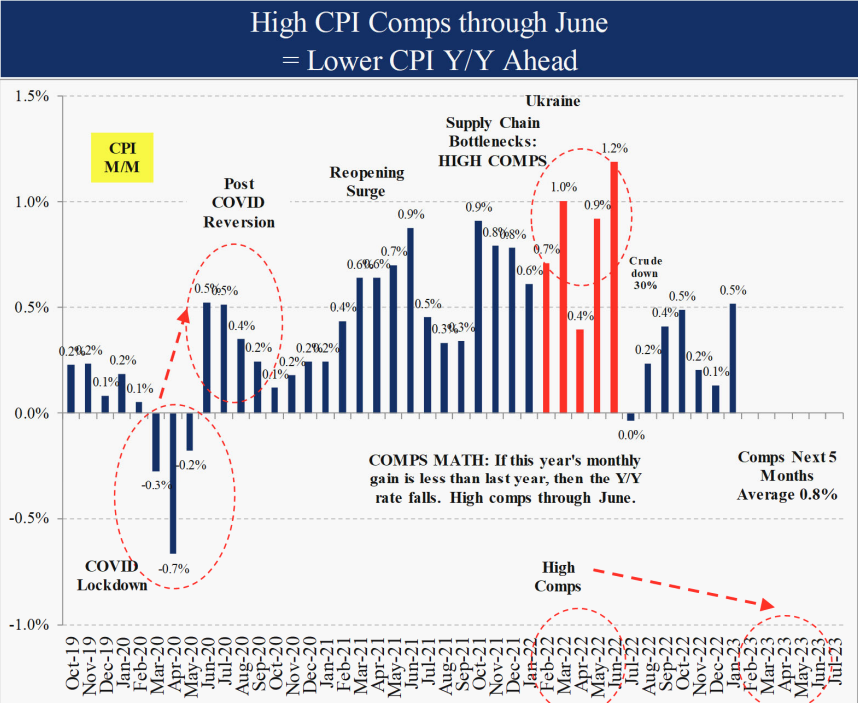
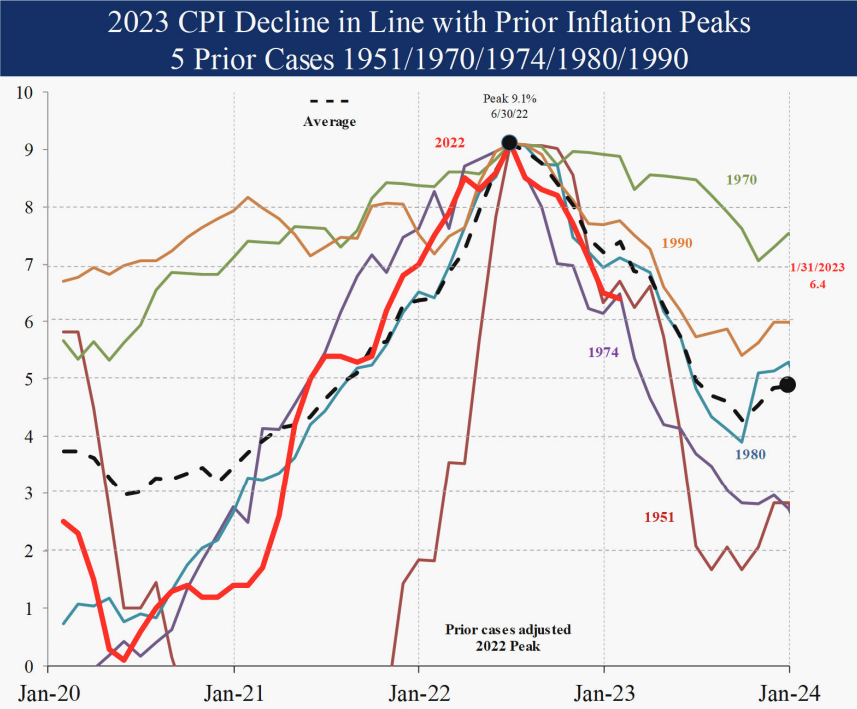
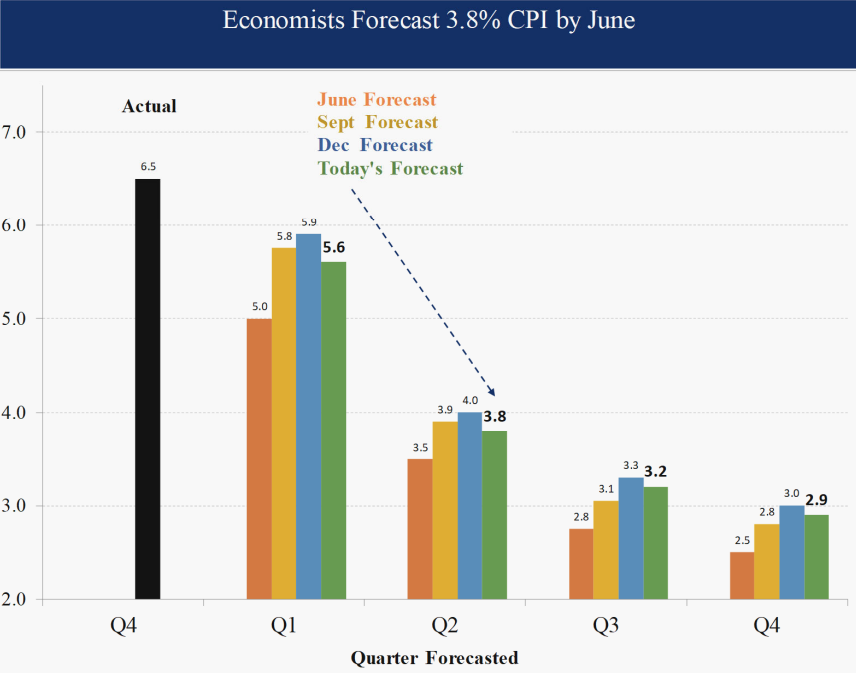
Summary
This month we discussed the uptick in the economic outlook indicators and the implications for asset prices. The improvement is further evidence the economy is close to a turn to the upside despite the media focus on an imminent recession ahead. It certainly does not rule out a recession, but for now, indicators show the economy will improve and inflation will continue lower, a bullish combination for equities and commodities. Long‐term bonds are at risk of yields moving higher. Whether the Fed hikes 2 or 3 more times this year is less important for asset prices than the next move in the economy and inflation trend. We will continue to monitor our indicators on a daily basis for changes to our outlook. Thank you for your support and please contact us with any questions.
IMPORTANT DISCLOSURES
This review and outlook report (this “Report”) is for informational, illustration and discussion purposes only and is not intended to be, nor should it be construed as, financial, legal, tax or investment advice, of Brenton Point Wealth Advisors LLC or any of its affiliates (“Brenton Point”). This Report does not take into account the investment objectives, financial situation, restrictions, particular needs or financial, legal or tax situation of any particular person and should not be viewed as addressing any recipient’s particular investment needs. Recipients should consider the information contained in this Report as only a single factor in making an investment decision and should not rely solely on investment recommendations contained herein, if any, as a substitution for the exercise of independent judgment of the merits and risks of investments.
This material is based upon information obtained from various sources that Brenton Point believes to be reliable, but Brenton Point makes no representation or warranty with respect to the accuracy or completeness of such information. Views expressed herein are current only as of the date indicated and are subject to change without notice.
This Report contains certain forward looking statements opinions, estimates, projections, assessments and other views (collectively “Statements”). These Statements are subject to a number of assumptions, risks and uncertainties which may cause actual results, performance or achievements to be materially different from future results, performance or achievements expressed or implied by these forward looking statements and projections. Brenton Point makes no representations as to the reasonableness of such assumptions or the likelihood that such assumptions will coincide with actual events and this information should not be relied upon for that purpose. Changes in such assumptions could produce materially different results. Past performance is not a guarantee or indication of future results, and no representation or warranty, express or implied, is made regarding future performance of any financial instrument mentioned in this Report.
Any benchmark shown herein is shown for illustrative purposes only. No index benchmark is available for direct investment. It may not be possible to replicate the returns of any index, as the index may not include any trading commissions and costs or fees, may assume the reinvestment of income, and may have investment objectives, use trading strategies, or have other materials characteristics, such as credit exposure or volatility, that do not make it suitable for a particular person. This is not an offer or solicitation for the purchase or sale of any security, investment, or other product and should not be construed as such. References to specific financial instruments and to certain indices are for illustrative purposes only and provided for the purpose of making general market data available as a point of reference only; they are not intended to be, and should not be interpreted as recommendations to purchase or sell such securities. Investing in securities and other financial products entails certain risks, including the possible loss of the entire principal amount invested, as the value of investment can go down as well as up. You should obtain advice from your tax, financial, legal, and other advisors and only make investment decisions on the basis of your own objectives, experience, and resources.
Brenton Point accepts no liability for any loss (whether direct, indirect or consequential) occasioned to any person acting or refraining from action as a result of any material contained in or derived from this Report, except to the extent (but only to the extent) that such liability may not be waived, modified or limited under applicable law.
This Report may provide addresses of, or contain hyperlinks to, Internet websites. Brenton Point has not reviewed the linked Internet website of any third party and takes no responsibility for the contents thereof. Each such address or hyperlink is provided solely for your convenience and information, and the content of linked third party websites is not in any way incorporated herein. Recipients who choose to access such third-party websites or follow such hyperlinks do so at their own risk.
All marks referenced herein are the property of their respective owners. This Report is licensed for non-commercial use only, and may not be reproduced, distributed, forwarded, posted, published, transmitted, uploaded or otherwise made available to others for commercial purposes, including to individuals within an institution, without written authorization from Brenton Point.
Source of data and performance statistics: Bloomberg L.P. and Factset Research Systems Inc.
©Brenton Point Wealth Advisors LLC 2023

Michael Schaus
Director of Market Research
Michael Schaus is the Director of Market Research for Brenton Point Wealth Advisors and Zweig-DiMenna. Since joining Zweig-DiMenna in 1992, his focus has been on macroeconomic research, the analysis of…
READ MORERead Next:
Sign up!
Sign up for our monthly newsletter and get the lastest news and research from our esteemed advisors here at Brenton point. Right into your inbox!


 Client Login
Client Login

